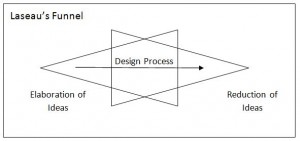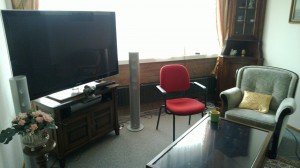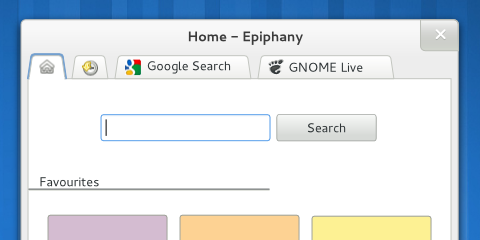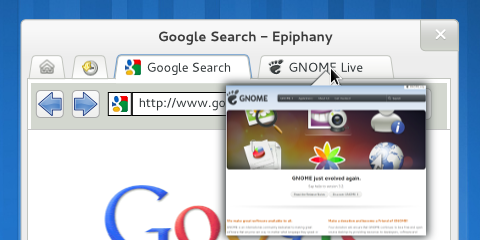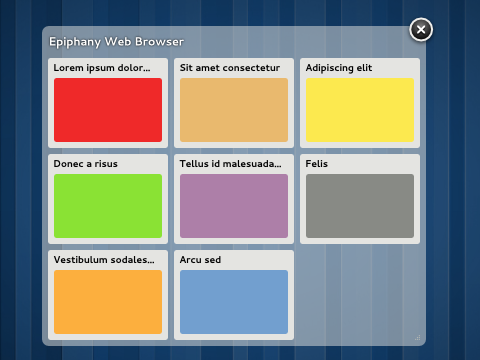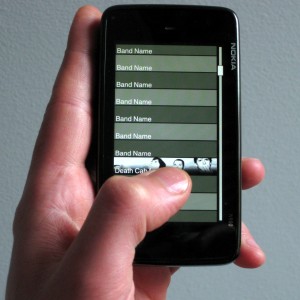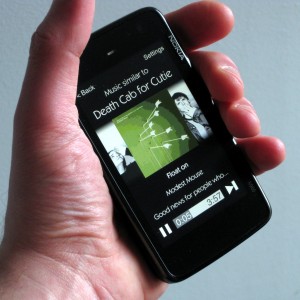Earlier this week I began to look at some of the many available works on the field of Web browsers for the desktop, with the goal of improving the design of the Epiphany browser and taking advantage of the fact that Igalia is one of the main maintainers of WebKitGTK+. The first task, of course, is to correctly understand the problem: in a field as big and complex as this, this means a lot of reading and synthesising. Today I will explore two particular aspects: revisitation and tabbed browsing. In the future I will expand on this and begin to share some design ideas.
Revisitation
Revisitation means to access web sites that have been already seen previously. Although there are discrepancies on how to measure it, for the sake of design we can say that we have already seen roughly half of the pages that we visit. The article by Obendorf et al. mentions three kinds of revisitation:
- short-term revisits (within the hour): these are the most common, often performed by following links, or using the Back button;
- mid-term revisits (within the day): the most usual way is to use bookmarks or write the URL (often helped by autocomplete);
- long-term revisits: this is related to the rediscovery of information that has already been seen; people re-access these pages mainly through links because they need to re-search (enter the same search terms) and/or re-trace (follow the same steps); history and bookmarks are also employed to some extent, but the current interfaces might not be easy or convenient to use.
Previously-unseen pages are usually visited by directly entering a URL or by following links from search pages (e.g. Google) or other information hubs (e.g. reddit, news sites).
A wider research was carried out by Adar, Teevan and Dumais. Their findings are consistent to those above, as they found that Web page revisitations could be clustered in the same three groups plus another one, which they called hybrid and which contained sites that were popular but infrequently used. They went further in trying to analyse the kind of web sites that typically fell on each group. The fast revisitation pattern often corresponded to “hub&spoke” behaviour, where users move back and forth between a set of promising results and each individual item. The mid-term one tended to refer to pages that act as starting points where the user can carry out a task (e.g. communication, banking) or access new information (e.g. news, forums). The infrequently-accessed group comprised pages that provide specialised search (e.g. travel) or related to weekend activities; as in the previous paper, the researchers also note that external search engines are often used for revisitation. There was a fourth, hybrid group of pages that caused “hub&spoke” movement but that were infrequently accessed, such as craigslist, eBay, shopping, games, etc.
With these results, the researches mention a number of implications for design. The most interesting for me is that “there may be value in providing awareness of, and grouping by, a broader range of revisitation patterns. For example, users may want to quickly sort previously visited pages into groups corresponding to a working stack (recently accessed fast pages), a frequent stack (medium and hybrid pages), and a searchable stack (slow pages).”
Research on tabs
During the last years the usage of tabs has made the Back button less prevalent. For instance, a common behaviour is to perform a search and then open different results in their own tabs, attempting to find the desired information through exploration of the candidates without losing track of the result set for further refinement. This often causes problems because the Back button does not work as expected (local history only applies to the current tab) and it might be complicated to find the originating document in the case of large tab trees. Problems with the Back button also arise when entering information through web forms and when using web applications.
A study of tab usage on Firefox showed that tabs are mostly used for immediate revisitation and task-switching. They serve as reminders or short-term bookmarks, they allow users to open links in the background and are a convenient way to keep frequently-accessed pages open. Visually, they are cleaner, less cluttered and easier to access that separate browser windows.
Many participants used tabs for revisitation more often than the back button, up to the point where, for frequent tabs users, tab switching was the second most frequent thing they did in the browser (after following links). The reasons reported were that tabs were more efficient, more convenient and more predictable (you can see the target right away). Another factor that helps to ease multitasking is that tabs leave the page in the same state, which is not always true with the back button.
The study found marked differences between regular and power tab users. The median number of open tabs was reported at around 6, but the maximum number of open tabs at one point in time could get much higher than that, past 20 and beyond for some users. As the participants were using regular Firefox, it could be that for some a limiting factor to the number of open tabs might simply be lack of space.
A bit of personal experience
As a user of the Tree-style Tabs extension for Firefox, I often find myself creating long trees of tabs where the tree itself marks a trail that is coherent and useful. I do not use the Back button often, and I think that the reason might be that opening a new branch in the tree somehow makes that part of the trail useful, clear and important, whereas pages that can only be accessed by going back soon fade out of memory. For a given task, it might well be that there is value in having a clear structure of related sites: the combination of tree-style tabs and the Back button helps create and navigate this structure.
Opening a link in a new tab actually marks the previous one as interesting and worth keeping around for a while, whereas closing a tab or following a link signals that the previous page was not that interesting after all (and it will fade from memory soon). This way of looking for information is probably related to orienteering, an information seeking strategy in which users take small steps towards their target using partial information and contextual knowledge as a guide. Making said set of steps visible and semi-permanent also acts as a very convenient reminder: my tab structure is kept between sessions, which makes it very easy to resume work or reading (for instance, there is a small subtree hanging from my RSS reader tab with articles that I will read later, and another one hanging from Bugzilla with bugs that I am working on).
Longer-term revisits
Regarding mid- and long-term revisits, I propose to contemplate three kinds of sites: web applications, information hubs and the personal archive. Web applications are self-contained and focused mainly on one task; their goal is in most cases to replace local applications for e.g. email, calendar, project planning, music, etc.
It might make sense to separate frequently visited websites that periodically provide new content from concrete and interesting information items; you can think about as the difference between reading the newspaper everyday and cutting out a news item that mentions your amateur football team. Information hubs are pages that are visited often because they lead to the discovery of new information, either on the same site (e.g. guardian.co.uk) or on others (e.g. reddit.com). On the other hand, the personal archive is a collection of information items that are relevant for the user because of the information that they already contain. There are many motivations behind the construction of personal archives: not just simply storing things for later retrieval, but also creating a legacy, making it easier to share resources, reducing fear of loss, self-expression and self-identity.
References
“Web Page Revisitation Revisited: Implications of a Long-term Click-stream Study of Browser Usage”, Obendorf et al., CHI 2007 Proceedings [PDF]
“A Study of Tabbed Browsing Among Mozilla Firefox Users”, Dubroy et al., CHI 2010 [PDF] [Presentation]
“Large Scale Analysis of Web Revisitation Patterns”, Adar et al., CHI 2008 [PDF]
“To have and to hold: exploring the personal archive”, Kaye et al., CHI 2006 [PDF]
“The Perfect Search Engine Is Not Enough:A Study of Orienteering Behavior in Directed Search”, Teevan et al., CHI 2004 [PDF]
Alex Faabor’s blog
Mozilla’s blog of metrics
Design proposals for Epiphany: EpiphanyRedux, hbon’s mockups




